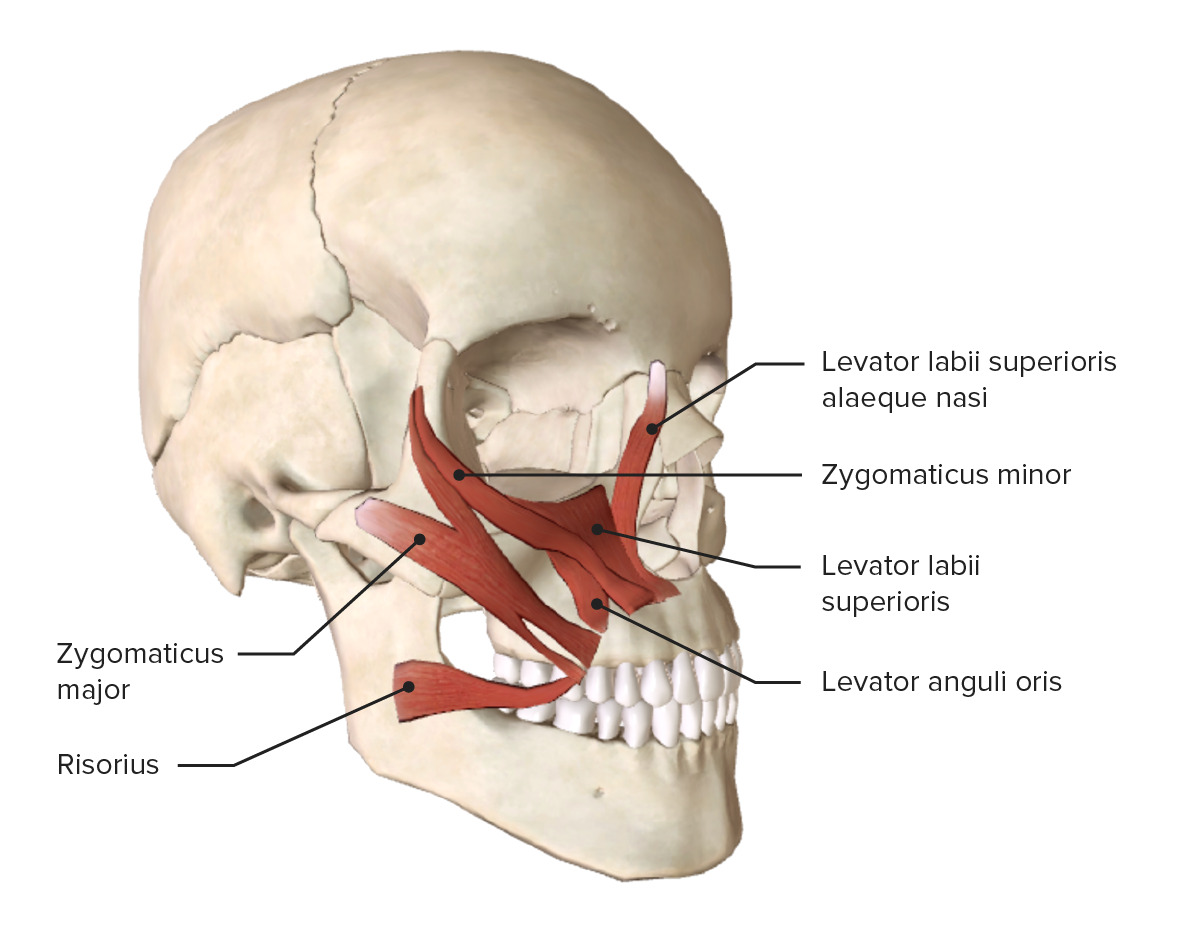Playlist
Show Playlist
Hide Playlist
Muscles of Facial Expression
-
Slides Anatomy Muscles of Facial Expression.pdf
-
Reference List Anatomy.pdf
-
Download Lecture Overview
00:01 Let's look at some of the muscles of the head starting with the muscles of facial expression. 00:08 The muscles of facial expression are just that they're the muscles that help create facial expressions that express communication in a nonverbal way. 00:21 We'll start by looking at the orbital group of muscles. 00:25 Starting with a circular muscle called the orbicularis oculi, that basically goes around the eye. 00:33 There's a palpable part, close to the eyelids. 00:37 That's what palpebral refers to. 00:39 And then the surrounding orbital part. 00:43 Together, they work to close the eyelids. 00:48 Just superiorly to that, we have the corrugator supercili and that draws the eyebrows immediately and downward. 00:58 And we also have the depressor supercili, which is going to draw the eyebrows downward as well. 01:06 Now, supercili in this case, as you might have guessed, refers to the eyebrows. 01:12 Next, we have the nasal group of muscles. 01:15 Superiorly, we start with the procerus. 01:18 That's going to draw the medial angle of the eyebrows down. 01:23 We also have the nasalis, over the bridge of the nose. 01:28 And that's going to sort of compress the nasal apertures. 01:31 And it's going to create a something of a flaring of the nostrils. 01:36 We also have the depressor septi, And that's going to pull the nose inferiorly as you And that's going to pull the nose inferiorly as you might have guessed by its location. 01:48 Then around the area of the mouth, we have the oral group. 01:51 We have the levator anguli oris, which raises the corners of the mouth, it's sort of what the word is saying in Latin, levator anguli oris, lifting up the angle of the mouth. 02:07 Then, we have the levator labii superioris, which is going to raise the upper lip. 02:15 Again, that's a descriptive name too. 02:17 Levator labii superioris with labii referring to lips. 02:23 We have levator labii superioris alaeque nasi, which sounds like a Harry Potter spell, but really is just a very long name for a muscle that raises the upper lip and the opening of the nostril. 02:37 We also have over in the zygomatic area, the zygomaticus minor and zygomaticus major. 02:45 And they're both going to draw the upper lip sort of upward and laterally in the direction of the muscle fibers. 02:53 We also have a more horizontally oriented risorius. 02:57 So they're going to retract the corners of the mouth. 03:01 Then we have a muscle that's pretty similar to orbicularis oculi, except it's going around the mouth, so we call it orbicularis oris. 03:10 And that's going to close the lips. 03:14 The depressor anguli oris has a descriptive name as well because it's going to draw the corners or angles of the mouth downward and laterally. 03:26 The depressor labii inferioris also tells you a lot of what it's doing. 03:31 It's going to draw the lower lips downward. 03:35 And then the area of the chin we have the mentalis. 03:37 Remember that menta refers to chin and that's going to sort of raise and protrude the lower lip. 03:47 The buccinator muscle in the area of the cheek, it's going to be important for pressing the cheek against the teeth, which is something that helps keep food between the teeth during the act of chewing. 04:01 We have a very wide flat yet very, very thin muscle called the platysma. 04:08 And that platysma is really not going to do a whole lot other than really change the shape of the skin of the neck when it's tensed. 04:17 We also have some auricular muscles, auricular referring to ear and we have one anteriorly, superiorly and posteriorly. 04:28 Although in humans they don't do a whole lot compared to other animals that have greater control of the ear such as dogs. 04:37 We have a muscle called occipitofrontalis that really is a muscle with two bellies, a frontal belly and that's going to cause wrinkling of the forehead sort of rising the of the eyebrows. 04:51 And then with a wide flat sheet called an aponeurosis, in this case, an epicranial aponeurosis, it will connect to the occipital belly and contraction of these muscles is going to draw the scalp backward.
About the Lecture
The lecture Muscles of Facial Expression by Darren Salmi, MD, MS is from the course Muscles of the Head.
Included Quiz Questions
What is the function of the orbicularis oculi?
- Closing of the eyelids
- Drawing the eyelids medially
- Drawing the eyelids downward
- Moving the eyes to the left
- Moving the eyes to the right
What is the function of the procerus?
- Drawing the medial angle of the eyebrows down
- Compression of the nasal aperture
- Pulling the nose inferiorly
- Pulling the nose superiorly
- Drawing the lateral angle of the eyebrows up
What is the function of the zygomaticus major?
- Drawing the upper lip upward and laterally
- Raising the upper lip
- Raising the corners of the mouth
- Opening the nostrils
- Retracting the corners of the mouth
What is the function of the anterior belly of the occipitofrontalis?
- Wrinkling of the forehead
- Drawing the scalp backward
- Drawing the lips downward
- Drawing the lips upward
- Closing the eyelids
Customer reviews
5,0 of 5 stars
| 5 Stars |
|
5 |
| 4 Stars |
|
0 |
| 3 Stars |
|
0 |
| 2 Stars |
|
0 |
| 1 Star |
|
0 |




